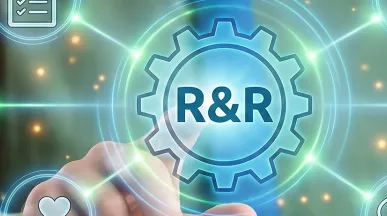How Recognition Boosts Employee Retention

By Gene Park
Employee recognition is an effective, low-cost solution to avoiding employee departures. “Recognition, applied in the right ways, can tip the balance towards why an employee will stay with a company,” says Inspirus Solutions Architect, Sean Mayo. “When an employee leaves, an organization doesn’t just lose a trained employee. An organization can also lose customers—depending on the relationships—as well as intellectual capital.”
Employee recognition is an effective, low-cost solution to avoiding employee departures.
“Recognition, applied in the right ways, can tip the balance towards why an employee will stay with a company,” says Inspirus Solutions Architect, Sean Mayo. “When an employee leaves, an organization doesn’t just lose a trained employee. An organization can also lose customers—depending on the relationships—as well as intellectual capital.”
Turnover can be detrimental to any organization.
- It can cost US companies a total of $536 billion per year.[1]
- When an employee leaves, it can take an average of: 42 days to find a replacement [2], and cost $15,000 to replace an employee earning $45,000 per year.[3]
Organizations can create an inclusive environment that attracts and retains talent by continuously engaging employees and acknowledging their work efforts. When rating factors that contribute to job satisfaction, respondents to a Society for Human Resource Management survey said respectful treatment of employees at all levels within an organization (65%) and recognition from management (45%) are very important.[4]
When organizations make recognition and engagement a priority within the workplace, employee absenteeism is reduced by 41% and turnover decreases by 59%.[5].
Here are four ways to ensure recognition plays a pivotal role throughout your work environment.
Seek leadership buy-in
In order for recognition to gain authority within an organization among employees, it’s essential that leadership believe in the process and its benefits to the company. When executives are committed to making employee recognition and employee appreciation a priority, it sets a standard that others will follow and continue throughout their daily interactions. In order for recognition to develop into a cultural value, this process can’t be treated like just another initiative that may eventually lose steam. It needs to be seen, experienced and practiced every day by all leadership (not just the HR department) in order for employees to understand that recognition is truly valued by the organization.
Address the importance of manager effectiveness
Managers are often the first impression employees have with a company and set the tone for the overall experience that employees have within an organization. This makes it all the more important that a manager’s actions align with the organization’s values. It’s also essential for managers to communicate expectations to employees while still being empathetic to challenges they may be facing. Recognition should be at the forefront when communicating with employees as well. When employees produce great work, go above and beyond in their role, or positively impact the organization, managers should the timely recognition that includes specific examples of how an employee provided value to the organization. This effort truly resonates with employees, as Gallup poll data shows that the most memorable recognition comes from an employee’s manager (28%) or an executive-level leader (24%).[6]
Develop a culture of appreciation
Taking the time to develop a culture that recognizes employees for their efforts (and behaviors) is a way for an organization to show their commitment to creating a space where employees can thrive. In turn, employees will be less likely to leave for another organization if they know they will be adding value when they do a good job. Organizations that implement recognition programs have 31% less employee turnover [7]. An effective way to build recognition and appreciation into an organization’s overall culture is to define which values matter most and ensure a recognition program incorporates these values and acknowledges employees whose actions align with them.
Create consistency in recognition
To ensure that employee recognition maintains momentum and positively impacts your workforce, structure and consistency are key. Without a formalized recognition format that managers can follow and replicate, employees’ experience with receiving recognition can vary greatly. For example, one manager may offer recognition for service anniversary only, where as another may dole out more frequent recognition for employees that help meet company initiatives. By developing a standardized structure to implement recognition organization-wide, all managers and employees will have the opportunity to recognize one another for the value and efforts they bring to the organization.
For recognition to really take off, a top-down approach can make the difference. “In one of my first jobs, our CEO would come around every week. He knew my name, he knew about my family, he knew what projects I was working on,” says Mayo. “It’s making recognition a priority, so that people feel the culture every day.”
Cultivating and retaining talent can be a challenge within any organization. Taking time to make sure current employees feel recognized and appreciated for their work can go a long way towards creating a workplace in which employees remain engaged, and productive and also recommend the company to other talent.
Footnotes
[1] Catalyst, Quick Take: Turnover and Retention, 2018.
[2] SHRM, Human Capital Benchmarking Report, 2016.
[3] HR Drive, Study: Turnover costs employers $15,000 per worker, 2017.
[4] SHRM, Employee Job Satisfaction and Engagement Survey, 2017.
[5] Gallup, The Right Culture: Not Just About Employee Satisfaction, 2017.
[6] Gallup, Employee Recognition: Low Cost, High Impact, 2016.
[7] Bersin by Deloitte, 2012.





